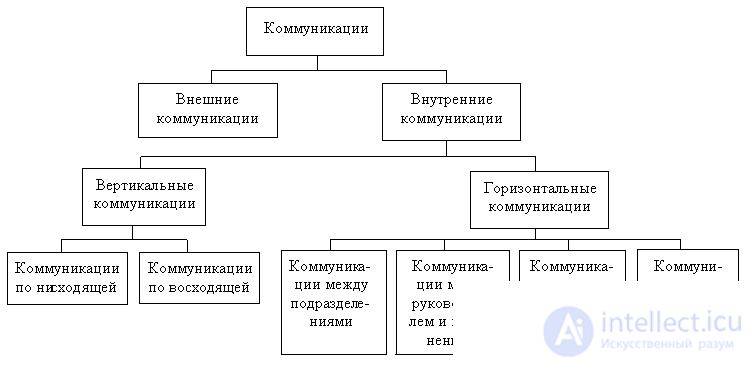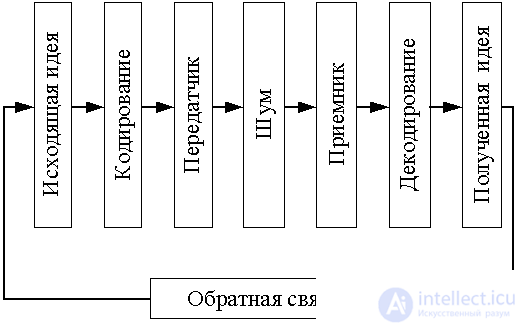Lecture
Communication is a process associated with interpersonal and organizational communication in the transmission of information both within the organization and with the external environment.
Therefore, communication can be divided into external and internal.
External is communication * between the organization and its environment (environment). Environmental factors have an increasing influence on the organization's activities. These factors (consumers, suppliers, competitors, etc.) determine the composition and content of external communications. Moreover, internal communications are often a reaction to the changing characteristics of the external environment. Organizations use various means of communication with the external environment:
Internal - this communication between structural units and individual performers.
Inter-level, vertical communications in organizations. In the context of vertical communications, information is moved within the organization from level to level. In this case, information can be transmitted in a descending and ascending manner.
In descending order, information is transmitted from higher levels to lower levels, acting as a direct link. In this way, the masters receive a plan-task for the month, changes in technology, a plan for equipment withdrawal for repair, etc.
Communications ascending, that is, from the bottom up, perform the function of feedback, inform managers about the state of affairs in the lower levels. Thus, the masters inform the foreman of the production process, the level of implementation of the plan, deviations from the plan, problems and possible ways to resolve them. This ascending information is usually transmitted in the form of reports, sentences and explanatory notes.
Horizontal communications. The organization consists of a large number of units that are closely interrelated. Coordination of the activities of all divisions in addition to the descending and ascending vertical information needs horizontal communications. The general trend is to strengthen the role of direct coordination of actions of unorganized divisions of the organization.
It is the information passing through horizontal communications, i.e., a short communication channel, that ensures the quality of the incoming information (reliability and timeliness). It forms equal relations between partners and therefore is an important component of the satisfaction of employees of the organization.
The considered vertical and horizontal communications operate within the framework of the official structure of the organization along the lines of the formal hierarchy of subordination and delegation of authority, as well as along the lines of formal subordination of horizontal interaction. However, within the organization there are and play an important role informal communication , which operate within an informal structure. These include rumors that have passed through the system of secret messages. Through the channels of rumors information is transmitted much faster than through the channels of formal communications. Often, managers use informal communications for a planned leak of information or information like “just between us”. These rumors include information about major upcoming changes in the organization: merging departments, staff reduction * , structural changes, etc.
Studies show that managers * spend most of their working time on communications (see Figure 3.11).
Communication is the key to management efficiency. Communication - verbal and written, formal and informal - goes through many channels and in different directions. The administration needs to make the transfer of the general course, directives, goals and objectives so that all employees understand and accept them. To keep people in control and to control them, there is no better management tool than understanding. The final test of communication is whether it provides the required results quickly and correctly.

Figure 4.1. Communication classification
Communication is an idea transplant. Virtually every area of human endeavor revolves around people's attempts to inculcate ideas into the consciousness of their colleagues.
The information explosion does not make things easier. Every day there are new ideas that need to be conveyed.
The transfer of information is carried out with the help of a gesture, speech, devices or in writing. It is through communications that information is transmitted to decision makers, and decisions are made to their performers.
A communication process is a process of exchanging information between two or more people.
The purpose of the communication process is to provide an understanding of the information transmitted, from the side of its recipient.
An elementary communication process * is shown in Fig. 4.2. Communication through feedback turns into a two-way road, and the process itself acquires dynamics. In this case, the feedback can be expressed not necessarily in the same code system as the received message. The main thing is that the code system is known to the new recipient. So, very often we reply to a phrase with a nod. For a manager, as well as for another person, feedback can act as a direct (directly observable change in behavior) and indirect (decrease in productivity, absenteeism, conflicts * , etc.).

Fig. 4.2. Diagram of the communication process.
The person who has the idea (1) decides to share it. The idea is then coded (2) in some form of written, spoken, or other language that can be conveyed by (3) symbols, sounds, or other means of expression. Unfortunately, almost never gets a closed circuit from the transmitter to the receiver (5). In the interim, interference (4) of all kinds lurks, ready to distort the message. Distracting noise and other distractions can change the original gear.
Differences in perception is a problem that is often ignored. The same message can have different meanings for people with different experiences or education. The pursuit of accuracy sometimes requires additional effort, but usually saves time in the future. Finally, regardless of the human factor, language itself creates difficulties.
When a message is perceived through the eyes, ears, or emotions of the second person, it is transmitted to the brain, where the language is decoded (6). The final impression is generated by the resulting idea (7). Unfortunately, the idea (7) corresponds exactly to the idea (1) only in theory. In actual practice, traps are placed at every step, interfering with clear communication. As Lewis Carroll, the author of "Alice in Wonderland," noted, "one of the greatest miracles in the world is the process of accurately conveying meaning from one mind to another."
The last important element of the communication process is the feedback resulting from the exchange of roles by the participants in the process. The recipient becomes the sender and vice versa, the sender becomes the recipient. Thus, the whole cycle is repeated again, but in a different direction. Feedback is the recipient's response to the message. It allows the sender to find out whether the message reached the addressee and in what sense.
Although this scheme is extremely simplified, it still provides a useful way of evaluating any communication undertaken.
Comments
To leave a comment
Management
Terms: Management